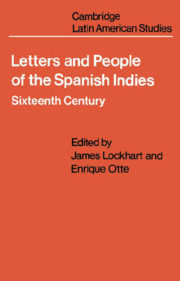Book contents
- Frontmatter
- Contents
- Preface
- Part I Conquest
- 1 Conquest in the personal view
- 2 A standard conqueror's report
- 3 The woman as conqueror
- 4 The merchant and the conquest of Peru
- 5 The merchant and the conquest of Mexico
- 6 The non-hero
- 7 The successful conqueror
- 8 The unsuccessful conqueror
- 9 The conqueror-governor
- 10 The conqueror in jail
- Part II The Variety of Life in the Indies
- Part III officials and Clerics
- Bibliography
- Index
5 - The merchant and the conquest of Mexico
from Part I - Conquest
Published online by Cambridge University Press: 06 August 2018
- Frontmatter
- Contents
- Preface
- Part I Conquest
- 1 Conquest in the personal view
- 2 A standard conqueror's report
- 3 The woman as conqueror
- 4 The merchant and the conquest of Peru
- 5 The merchant and the conquest of Mexico
- 6 The non-hero
- 7 The successful conqueror
- 8 The unsuccessful conqueror
- 9 The conqueror-governor
- 10 The conqueror in jail
- Part II The Variety of Life in the Indies
- Part III officials and Clerics
- Bibliography
- Index
Summary
Hernando de Castro, in Santiago, Cuba, to his senior partner Alonso de Nebreda in Seville, 1520
… This Cortes is in that city, some sixty or seventy leagues from the sea …
Until all are at peace, it is clearly no time to do business …
Having been introduced to some aspects of mercantile organization and correspondence in Letter 4, the reader will perhaps be prepared for this letter, written earlier but longer and more complex. Here, in addition to the characteristics seen before, we glimpse the operation of a large-scale commercial network with branches and representatives in several places at once. In the letter, names fly by bewilderingly. Without trying to be exhaustive, let us detail some of the most important figures. All were from Burgos, Old Castile, the town whose merchants, in the period before the discovery of America, long shared dominance of Spanish international trade with the Genoese.
(1)Alonso de Nebreda, recipient of the present letter, based in Seville, the head of interests trading towards both Flanders and the Caribbean.
(2)Juan de Rios, Nebreda's brother-in-law as well as longstanding factor and partner, based in Santo Domingo.
(3)Hernando de Castro, writer of the present letter, from a prominent Burgos family, important investor along with Nebreda and Rios in a new venture to sell goods in Cuba and ‘Yucatan'; yet acting as factor and junior partner, based in Santiago, Cuba.
(4)The Herrera brothers: (a) Francisco; referred to here sometimes as ‘Herrera’ and ‘young Francisco,’ Castro's chief aide, who despite intentions to leave eventually succeeded Castro as the company's factor in Santiago. (b) Juan, working for Juan de Rios, the Santo Domingo representative; in Rios’ name, he took merchandise to Mexico, selling it to:
(5)Pedro de Maluenda, Hernando de Castro's cousin, not part of the Nebreda-Castro enterprise at the moment, but in Mexico as a representative of Cuban governor Diego velazquez.
(6)Fernando de Santa Cruz, nephew of Castro, killed in a shipwreck on his way to Mexico, taking merchandise for his father,
(7)Juan Fernandez, in Seville, who was Castro's cousin, as well as his associate in selling black slaves.
- Type
- Chapter
- Information
- Letters and People of the Spanish IndiesSixteenth Century, pp. 24 - 38Publisher: Cambridge University PressPrint publication year: 1976



